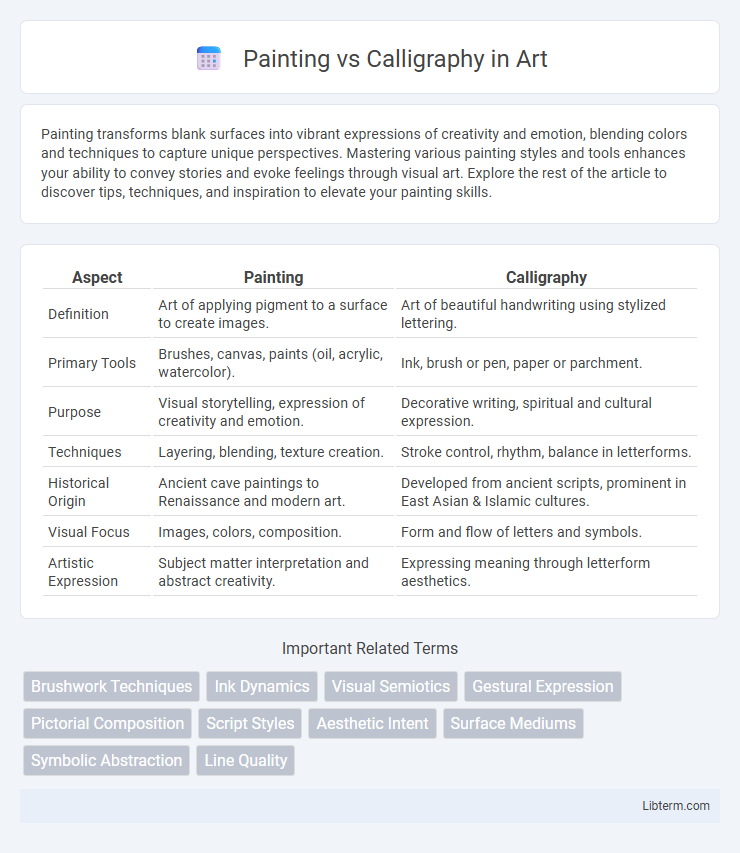Painting transforms blank surfaces into vibrant expressions of creativity and emotion, blending colors and techniques to capture unique perspectives. Mastering various painting styles and tools enhances your ability to convey stories and evoke feelings through visual art. Explore the rest of the article to discover tips, techniques, and inspiration to elevate your painting skills.
Table of Comparison
| Aspect | Painting | Calligraphy |
|---|---|---|
| Definition | Art of applying pigment to a surface to create images. | Art of beautiful handwriting using stylized lettering. |
| Primary Tools | Brushes, canvas, paints (oil, acrylic, watercolor). | Ink, brush or pen, paper or parchment. |
| Purpose | Visual storytelling, expression of creativity and emotion. | Decorative writing, spiritual and cultural expression. |
| Techniques | Layering, blending, texture creation. | Stroke control, rhythm, balance in letterforms. |
| Historical Origin | Ancient cave paintings to Renaissance and modern art. | Developed from ancient scripts, prominent in East Asian & Islamic cultures. |
| Visual Focus | Images, colors, composition. | Form and flow of letters and symbols. |
| Artistic Expression | Subject matter interpretation and abstract creativity. | Expressing meaning through letterform aesthetics. |
Introduction to Painting and Calligraphy
Painting utilizes pigments applied to surfaces such as canvas or paper to create visual compositions emphasizing color, texture, and form. Calligraphy involves the artful writing of characters or letters using brushes or pens, focusing on stylized and expressive strokes. Both disciplines showcase aesthetic creativity but differ fundamentally in tools, techniques, and cultural significance.
Historical Background of Both Arts
Painting and calligraphy have distinct historical backgrounds rooted in cultural and artistic traditions; painting dates back to prehistoric cave art around 30,000 BCE, evolving through classical antiquity, Renaissance, and modern periods, reflecting diverse techniques and thematic developments. Calligraphy, originating in ancient Mesopotamia and refined in East Asian cultures like China and Japan, emphasized the art of beautiful handwriting using brush and ink, serving both aesthetic and communicative purposes within religious and literary contexts. Both arts developed as significant forms of expression, with painting often focusing on visual representation and calligraphy centered on stylized script as a visual art form.
Techniques and Materials Used
Painting relies on diverse techniques such as brushwork, layering, glazing, and impasto, with materials including oil, acrylic, watercolor paints, canvas, and various textured papers. Calligraphy emphasizes precise brush strokes, pen pressure control, and ink flow, using specialized tools like dip pens, nibs, brushes, and high-quality ink on rice paper or parchment. Both arts require mastery of form and medium, but painting focuses on color blending and texture, while calligraphy prioritizes line quality and rhythm.
Expressive Differences in Visual Language
Painting employs color, texture, and form to convey emotions and narratives through visual depth and composition, creating an immersive sensory experience. Calligraphy relies on the rhythm, flow, and stylistic variations of letterforms to express meaning and personality within linguistic constraints. The expressive difference lies in painting's abstract, multisensory imagery versus calligraphy's structured, symbolic representation of language.
Cultural Significance and Symbolism
Painting serves as a visual narrative reflecting cultural identity through imagery, colors, and techniques unique to each region, symbolizing heritage and historical events. Calligraphy embodies spiritual and philosophical ideals, particularly in cultures such as Arabic and East Asian, where the art of beautiful writing represents harmony, discipline, and sacred texts. Both forms reveal deep cultural values, with painting often conveying collective memory and calligraphy expressing individual artistic devotion and cultural continuity.
Aesthetic Principles Compared
Painting emphasizes color harmony, composition balance, and texture variety to create visual impact, often exploring depth and light dynamics. Calligraphy prioritizes fluidity, rhythm, and the expressive beauty of individual strokes, with an emphasis on line quality and spatial arrangement. Both art forms rely on mastery of form and contrast, but painting focuses more on imagery while calligraphy centers on the elegance of written characters.
Skill Development and Learning Curve
Painting develops fine motor skills and visual-spatial awareness through brush control and color blending, requiring practice to master techniques like shading and texture. Calligraphy demands precise hand-eye coordination, steady hand movements, and mastery of letterforms, with a steep learning curve focused on rhythm and consistency. Both art forms enhance creativity, but calligraphy typically requires more disciplined repetition to achieve fluidity and uniformity in writing.
Modern Interpretations and Innovations
Modern interpretations of painting incorporate digital technologies, mixed media, and abstract expressionism to push traditional boundaries, emphasizing visual storytelling and emotional depth. Calligraphy innovations blend classical brush techniques with digital artistry and experimental typography, creating dynamic, interactive scripts that transcend conventional forms. Both art forms increasingly explore interdisciplinary approaches, integrating cultural heritage with contemporary technology to redefine aesthetic and communicative possibilities.
Applications in Contemporary Art and Design
Painting in contemporary art emphasizes expressive color, texture, and form to create visually impactful compositions, widely used in murals, galleries, and digital media. Calligraphy integrates elegant letterforms and cultural symbolism, often employed in branding, packaging design, and fine art installations to convey narrative and aesthetic refinement. Both practices intersect in modern design to blend visual storytelling with artistic craftsmanship, enhancing visual communication and cultural resonance.
Conclusion: Bridging the Gap Between Painting and Calligraphy
Painting and calligraphy converge as expressive art forms that emphasize mastery of brush technique and purposeful composition. Both disciplines utilize rhythm, balance, and flow to convey meaning beyond literal representation, creating a harmonious visual language. Embracing the shared aesthetics and principles of painting and calligraphy fosters innovative artistic practices that bridge cultural and stylistic boundaries.
Painting Infographic

 libterm.com
libterm.com